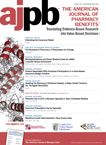Publication
Article
AJPB® Translating Evidence-Based Research Into Value-Based Decisions®
Heeding the Warning of Childhood Obesity, a Major Health Threat to Our Youngest Generation
Today's youth risk becoming the first generation not to outlive their parents. It is not too late, however, to halt and reverse this trend.
Not a week goes by without a slew of new reports in both the popular media and the scientific literature about childhood obesity in America. Childhood obesity rates have tripled in the past 20 years, reaching the point where 2 out of 3 kids today are either overweight or obese. Statistics like these paint the picture of a modern day health epidemic that has reached heretofore unimaginable dimensions. As disconcerting as these numbers are now, the long-term health threat that childhood obesity poses is downright startling.
The American Heart Association has targeted childhood obesity as a cornerstone strategic priority, because its implications for the cardiovascular health of future generations are potentially devastating. Our approach is to leave no door unopened until the problem is solved, and we are encouraged by the fact that many fellow stakeholders in the health sector share our concern and determination to overcome this challenge.
In the past year the Association has embarked on 2 new partnerships to address childhood obesity. One is “Voices for Healthy Kids,” an advocacy-based program with the Robert Wood Johnson Foundation to build healthier environments for kids and their families. Together, we are targeting 6 focus areas: improving school nutrition; reducing consumption of sugary beverages; protecting kids from unhealthy and misleading food and beverage marketing; increasing access to affordable healthy foods; increasing access to parks, playgrounds, walking paths, bike lanes, and other opportunities to be physically active; and helping schools and youth-serving programs increase children’s physical activity levels.
In our other new partnership initiative, “Healthy Way to Grow,” we are working with the William G. McGowan Charitable Fund and Nemours to create a technical assistance program for child care centers aimed at decreasing obesity among children up to 5 years of age. We are helping centers achieve best practice guidelines in nutrition, physical activity, limited screen time, and infant feeding to help America’s youngest children grow up healthy.
In 2005, we proudly joined with the William J. Clinton Foundation as cofounders of the Alliance for a Healthier Generation, which works with schools, companies, community organizations, healthcare professionals, and families to transform the conditions and systems that lead to unhealthy kids. The Alliance reaches about 11.5 million kids a day, with resources modeled from the American Heart Association’s science and research. Fifty percent of our participating schools have improved the nutritional value of their school meals, and more than half dedicate at least 20% of after school program time to physical activity.
Our Teaching Gardens program shows elementary school students how to plant seeds, nurture growing plants, harvest produce, and ultimately unders tand the value of good eating habits. We launched this initiative 2 years ago with noted child nutrition activist and philanthropist Kelly Meyer, and so far the program has helped more than 200 elementary schools create their own gardens.
All of the above-mentioned initiatives strive to instill healthy everyday habits that can be maintained for a lifetime. This is the key to preventing cardiovascular diseases and achieving optimum levels of 7 key health factors and behaviors that the American Heart Association refers to as “Life’s Simple 7,” which are: regular physical activity, a healthy diet, avoiding cigarettes and other tobacco products, maintaining healthy blood pressure, blood cholesterol, and blood sugar levels, and keeping your body mass index (BMI) within a healthy range.
As recently as 2 decades ago, risk factors like high blood pressure and diabetes were almost exclusively seen in adults. Today, however, these have become increasingly prevalent in children and teens, a development that is clearly attributable to childhood obesity. For example, a study last summer documented a 27% increase in high blood pressure rates among children and adolescents over a recent 13-year period, with obesity cited as the principal related factor.1 In a 2008 study, researchers used ultrasound to measure the thickness of the arteries of adults and children, and found that the arterial health of obese children in the study was more typical of a 45-year-old than of someone their own age.2
Not surprisingly, obesity during childhood is highly predictive of less-than-ideal health in adulthood. Overweight children have a 70% to 80% chance of remaining overweight their entire lives.3 And according to research presented in September 2013, childhood obesity quadruples your likelihood of developing hypertension as an adult.4 Excess weight at a young age has even been linked to higher and earlier death rates in adulthood.5
Psychosocial issues are also a consequence. There is ample evidence identifying lower psychological wellbeing among overweight children, resulting in elevated levels of loneliness, sadness, and nervousness. Obese children are more prone to low self-esteem, negative body image, and depression. The epidemic has become so urgent that the American Heart Association recently created a new category of risk, called “severely obese,” to refer to the 5% of US youth with a BMI that’s at least 20% higher than the 95th percentile for their gender and age, or a BMI score of 35 or higher. Youth in this category have a substantially higher probability of developing premature heart disease.
A clear warning has been sounded, and if we do not heed its call, today’s youth are at real risk of becoming the first generation in history not to outlive their parents. It is not too late to first halt, and then reverse, this multi-decade trend. It will require an even higher level of awareness of obesity’s impact, and an even greater will to conquer it. But it can be done, and it must be done. There is no excuse for accepting the status quo.







